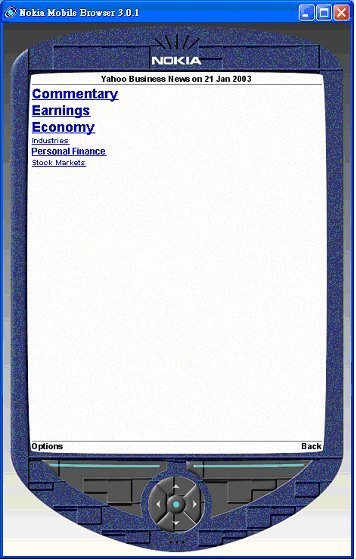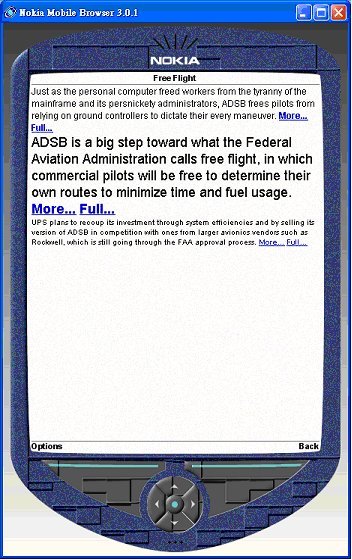
Wireless access with mobile devices is a promising addition to the WWW and traditional electronic business. Mobile devices provide convenience and portable access to the huge information space on the Internet. It is desire to access the most updated financial information through mobile devices in order to make critical and urgent decision for most of the investors. In this paper, we present a financial news delivery system on mobile devices based on the fractal summarization model. Fractal summarization is developed based on the fractal theory. It generates a brief skeleton of summary at the first stage, and the details of the summary on different levels of the document are generated on demands of users. Such interactive summarization reduces the computation load in comparing with the generation of the entire summary in one batch by the traditional summarization, which is ideal for wireless access.
Document summarization, financial news delivery, fisheye view, fractal view, handheld devices, mobile commerce.
Access to the Internet through mobile phones and other handheld devices is growing significantly in recent years. A lot of user-centered m-services applications, such as web surfing, e-mail checking, and stock price quoting, have been developed. However, m-services should not be limited to user-centered applications but extended to knowledge management. There is a large amount of financial news generated in the Internet everyday. With a fast paced economy, an m-commerce organization must gain advantage by accessing the most updated and accurate financial information available and make decision as fast as possible. As a result, it is desire to have financial news delivery through mobile devices so that investors can retrieve relevant information anywhere any time. Because of the huge volume of the news generated everyday, most of news delivery services provide summarization tools to support users in searching relevant information through Web browser on PC platforms, such as Lycos Financial Feed System with summarization system from Diyatech and YellowBrix with Inxight's Summarizer. Unfortunately, there are many shortcomings associated with mobile devices, such as limited screen size, narrow network bandwidth, small memory capacity and low computing power. Summarizers for PC platform are not adaptable to mobile devices directly. In order to reduce the information displayed and downloading time, a WAP gateway is setup to summarize the news for users to preview its major content. The wireless handheld devices can conduct interactive navigation with the gateway through wireless network to retrieve the summary piece by piece. In this paper, we present a financial news delivery system on mobile devices based on the fractal summarization model. In addition, information visualization techniques are presented to reduce the visual loads.
Traditional automatic text summarization is the selection of sentences from the source document based on their significance to the document [2][9]. The selection is based on the salient features of document, such as thematic, location, title, and cue features.
Typical summarization systems obtain the sentence weights by computing the weighted sum of the weights of all the features [2][8]. The sentences with sentence weight higher than a threshold value are selected as part of the summary. It has been proved that the weighting of different features does not have any substantial effect on the average precision [8]. The maximal weights of each feature are normalized to one in our system.
The traditional summarization models consider the source document as a sequence of sentences. However, many studies [3][5] of human abstraction process have shown that the human abstractors extract the topic sentences according to the document structure from the top level to the low level until they have extracted sufficient information. On the other hand, it is believed that the document summarization on handheld devices must make use of "tree view" [1] and "hierarchical display", which is not suitable for a sequence of sentences. Fractal summarization model is developed based on the fractal theory [10]. In fractal summarization, the important information is captured from the source text by exploring the hierarchical structure and salient features of the document. A condensed version of the document that is informatively close to the original is produced iteratively using the contractive transformation in the fractal theory. Similar to the fractal geometry, large document has a hierarchical structure with several levels, chapters, sections, subsections, paragraphs, sentences, terms, words and characters. At the lower abstraction level of a document, more specific information can be obtained. Although a document is not a true mathematical fractal object since a document cannot be viewed in an infinite abstraction level, we may consider a document as a prefractal [4]. The lowest abstraction level in our consideration is a term. The fractal summarization model applies a similar technique as fractal image compression [7]; it generates the summary by a simple recursive deterministic algorithm based on the iterated representation of a document. In fractal summarization, the user specifies the compression ratio of summarization. The default value of compression ratio is 4%, because high-compression ratio summary can achieve a reasonable high precision [13] and it can save network bandwidth. The system will use the compression ratio to calculate the total number of sentences to be extracted as the summary and the source document is segmented into range blocks of text according to the document structure (Figure 1). The system will calculate the sentence weight as the traditional summarization and allocate the quota of sentence to each range block proportionally to the sum of sentence weight in the range block. Each range block is then iteratively partitioned to child blocks and the quota is propagated down the summarization tree according to the sum of sentence weights in the child blocks until a contractive mapping is found to transform the text block to less than five sentences by traditional summarization methods, because it is proven that the optimal length of summary by extraction of fixed number of sentences is three to five sentences [6]. The summaries generated by fractal summarized are remained as tree structure, which are suitable for hierarchical display on handheld devices. Experiments have shown that the fractal summarization outperforms the traditional summarization [14]. In the paper, fractal summarization is used to summarize Hong Kong Annual Report 2000 that is a typical large document with hierarchical document structure. Five subjects were asked to evaluate the quality of summaries generated by fractal summarization and traditional summarization. Summaries are assigned to each subject in random order without telling the generation methods of the summaries. All subjects consider the summary generated by fractal summarization method as a better summary. The fractal summarization can achieve up to 88.75% precision and 84% on average, while the traditional summarization can achieve up to maximum 77.5% precision and 67% on average.
Fractal summarization model summarize the documents based on hierarchical document structure. In addition to large text document, a lot of other documents also exhibit hierarchical document structure, such as web-site and newspaper. The model is applied to summarize the financial news downloaded from Yahoo! News. Because a large volume of news articles is generated everyday, categorization is required for easy searching and browsing of news. For example, there are twenty-one categories in the Yahoo! News, each of them will be subdivided into subcategories. Each subcategory contains around ten news articles, each news article may contain more than one section, and each section contains few paragraphs, each paragraph contains few sentences. As we are interested with financial news, we will focus on Yahoo! News-'Business' category only.

Figure 1. Fractal Summarization of Yahoo! News-'Business' Category.
Figure 1 illustrates the fractal summarization of Yahoo! News-'Business' category. Fractal summarization generates a brief skeleton of summary at the first stage, and the details of the summary at different levels of the news tree are generated on demands of users. The system will first show a card contains with 6 subcategories of 'Business' category (Figure 2a), it gives user a general idea how the news articles are organized, and the user can select subcategory to obtain more details. Such interactive summarization reduces the computation load in comparing with the generation of the entire summary in one batch by the traditional automatic summarization, which is ideal for m-services.
 |  |
(a) Subcategories | (b)Summary of News |
Figure 2. Screen of WAP Summarization System.
Given a card of a summary node, there may be too many sentences or child-nodes to be visualized or displayed in the small screen of the hand held devices. In our system, the size of objects depends on the significance of the objects. The 3-scale font mode available for WML is utilized. The prototype system using Nokia Handset Simulator is presented on Figure 2. As shown in Figure 2a, 3 subcategories of Business category are displayed in large font, which means that they are more important; and the rest are in normal font or small font according to their importance. When the user click the anchor link of subcategory, the WAP gateway will delivery a card depends on the quota allocated. If a large quota is allocated to the subcategory, the system will show another card containing of index of news article. However, if the quota is less than 5 sentences, the system will show a card with the summary of all news articles in the subcategory (Figure 2b). In the summary page, when the user clicks the anchor link 'More' at end of each sentence, the system will generate the summary for the corresponding news articles with compression ratio 20%, because it has been proved that extraction of 20% sentences can be as informative as the full text of the source document [11]. On the other hand, the user can clicks the anchor link 'Full' to view the full text of the news articles.